Since 2016, I have been working on projects related to identifying the deep Pacific Ocean’s role in carbon storage during glacial periods. This work has resulted in a Nature Communications paper, an invited review article in Quaternary Science Reviews, and an invited science highlight in Past Global Changes Magazine. Check out some of our results below:
Ice-age storage of respired carbon in the Pacific Ocean
Past Global Changes Magazine, (2019)
Proxy-based reconstructions of oceanic dissolved oxygen and carbon concentrations have helped to refine our understanding of past ocean-atmosphere carbon partitioning, consistently indicating lower dissolved oxygen in the deep Pacific Ocean during the last ice age. Better quantitative and spatio-temporally resolved estimates of these parameters are critical for closing the carbon budget and elucidating the relative importance of the mechanisms and feedbacks driving past carbon exchange among Earth's carbon reservoirs.
Authors: A.W. Jacobel, R.F. Anderson, B.A.A. Hoogakker, and S.L. Jaccard
Modern distribution of oxygen in the Pacific Ocean. South-to-north transect from 150°W and west-to-east transect along the equator. Data from the PACIFICA dataset (Suzuki et al. 2013). Figure composed using Ocean Data View with in situ data gridded using data-interpolating variational analysis (Schlitzer 2018).
Deep Pacific storage of respired carbon during the last ice age: Perspectives from bottom water oxygen reconstructions
Invited - Quaternary Science Reviews, (2020)
Reconstructions of past changes in dissolved oxygen concentrations in the abyssal ocean are of interest to paleoceanographers because of their potential to help characterize and quantify the transfer of carbon between the atmosphere and the deep ocean. This potential, derived from the stoichiometric relationship between oxygen consumption and the regeneration of organic matter, has recently been expanded by compilations of core top observations for two proxies: the d13C gradient between coeval infaunal and epifaunal benthic foraminifera (Dd13C), and biomarker preservation. Here, we review these newer proxies, and the more established redox proxy authigenic uranium (aU), to critically evaluate our understanding of the controls on proxy signal production and preservation. We locate our work in the equatorial Pacific, presenting both new data and a compilation of existing records from thirty-two sediment cores to draw semi-quantitative conclusions about bottom water oxygen and respired carbon concentrations over the last glacial period. We find that the biogeochemical limitations on these proxies may be more substantial than previously appreciated, and therefore suggest several best-practice recommendations for their application. Despite the recognized data limitations, the compilation identifies the glacial Pacific Ocean as a dominant sink for CO2 at all depths below the modern oxygen minimum zone. Our review emphasizes the importance of multiproxy reconstructions, informed by site-specific records of paleoproductivity, in drawing coherent, internally consistent conclusions about glacial ocean oxygenation and carbon storage.
Authors: A.W. Jacobel, R.F. Anderson, S.L. Jaccard, J.F. McManus, F.J. Pavia, and G. Winckler
Map of Study Sites. Map of the equatorial Pacific Ocean with study sites numbered from west to east. A) Map view. B) Cross sectional view with colored contours indicating modern oxygen concentrations in mol/kg. Figures made using Ocean Data View software (Schlitzer, 2016) with basemap oxygen data from (Suzuki et al., 2013). Please see article for core reference information.
Maps of study area. Modern oxygen concentrations in μmol/kg with the locations of Pacific records of bottom water oxygen as recorded by aU from ML1208-17PC (this study) (diamond), RC11-238 and RC13-140 (dots), TT013-PC7237 (square), ODP 849 and MD97-2138 (inverted triangles) (a). The lower panel shows modern Δ14C-concentrations with radiocarbon from TTN013-18 (open triangle), and GS7202-15, PLDS 7G, VNTR01 10 GC, KNR73 3PC, KNR73 4PC, KNR73 6PG and S67 15FFC (open circles). Basemaps made using Ocean Data View.
Repeated storage of respired carbon in the equatorial Pacific Ocean over the last three glacial cycles
Nature Communications, 8 (2017)
Abstract:
As the largest reservoir of carbon exchanging with the atmosphere on glacial-interglacial timescales, the deep ocean has been implicated as the likely location of carbon sequestration during Pleistocene glaciations. Despite strong theoretical underpinning for this expectation, radiocarbon data on watermass ventilation ages are conflicting, and proxy interpretations disagree about the depth, origin and even existence of the respired carbon pool. Because any change in the storage of respiratory carbon is accompanied by corresponding changes in dissolved oxygen concentrations, proxy data reflecting oxygenation are of value in addressing these apparent inconsistencies. We present a record of redox-sensitive uranium from the central equatorial Pacific to identify intervals associated with respiratory carbon storage over the past 350 kyr and find evidence for repeated carbon storage over the last three glacial cycles. We also synthesize our data with previous work and propose an internally consistent picture of glacial carbon storage and equatorial Pacific watermass structure.
Authors: A.W. Jacobel, J.F. McManus, R.F. Anderson and G. Winckler



